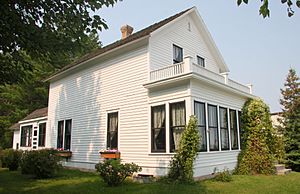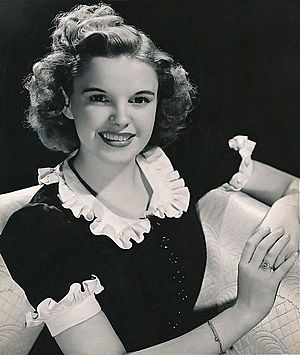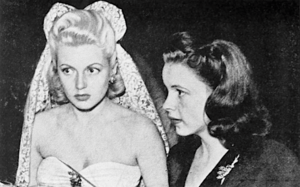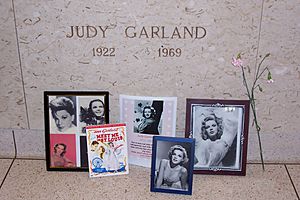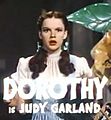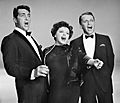Judy Garland facts for kids
Quick facts for kids
Judy Garland
|
|
|---|---|
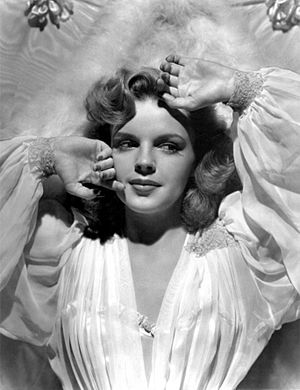
Garland in Presenting Lily Mars
|
|
| Born |
Frances Ethel Gumm
June 10, 1922 |
| Died | June 22, 1969 (aged 47) |
| Nationality | American |
| Years active | 1929 - 1969 |
| Spouse(s) | David Rose (m. 1941-1945, divorced) Vincente Minnelli (m. 1945-1951, divorced) Sidney Luft (m. 1952-1965, divorced) Mark Herron (m. 1965-1967, divorced) Mickey Deans (m. 1969-1969, her death) |
| Children | Liza Minnelli (b. 1946) Lorna Luft (b. 1952) Joey Luft (b. 1955) |
| Parent(s) | Frank Gumm Ethel (née Milne) |
Judy Garland (born Frances Ethel Gumm; June 10, 1922 – June 22, 1969) was a famous American singer, actress, and dancer. She became a huge star around the world during her 45-year career. Judy was known for her amazing singing and acting in both musicals and serious movies. She also made many popular recordings and performed in concerts.
Judy Garland won several important awards. These include a special Academy Award for young performers, a Golden Globe Award, and a Special Tony Award. She was also the first woman to win the Grammy Award for Album of the Year. This was for her live album Judy at Carnegie Hall in 1961.
As a child, Judy started performing in vaudeville with her two older sisters. When she was a teenager, she signed with Metro-Goldwyn-Mayer (MGM) film studio. She made over 20 movies with MGM. Her most famous role was playing Dorothy Gale in The Wizard of Oz (1939). Judy often acted alongside Mickey Rooney and Gene Kelly. She also worked a lot with director Vincente Minnelli, who later became her husband.
Other popular films she made with MGM include Meet Me in St. Louis (1944), The Harvey Girls (1946), Easter Parade (1948) with Fred Astaire, and Summer Stock (1950). Judy left MGM in 1950 after 15 years. This was due to personal challenges that made it hard for her to finish her work.
After leaving MGM, she made fewer films. However, she still earned two Academy Award nominations. These were for her roles in A Star Is Born (1954) and Judgment at Nuremberg (1961). She also gave record-breaking concerts and released eight studio albums. Judy even had her own TV show, The Judy Garland Show (1963–1964), which was nominated for an Emmy Award.
At 39, Judy Garland received the Cecil B. DeMille Award. This award is for lifetime achievements in the film industry. She was the youngest person and the first woman to get it. In 1997, she was given a Grammy Lifetime Achievement Award after her death. Many of her songs are in the Grammy Hall of Fame. In 1999, the American Film Institute named her one of the 10 greatest female stars in classic American movies.
Contents
Early Life and Family
Judy Garland was born Frances Ethel Gumm in Grand Rapids, Minnesota. She was the youngest of three children. Her parents were performers in vaudeville, a type of theater show. They moved to Grand Rapids to run a movie theater that also had live vaudeville acts. Judy was named after her parents and was baptized in a local Episcopal church. Her family had Irish, English, and Scottish roots.
From a very young age, "Baby" (as her family called her) loved to sing and dance. Her first time on stage was at two and a half years old. She joined her older sisters, Mary Jane and Dorothy Virginia, at her father's theater during a Christmas show. They sang "Jingle Bells". The Gumm Sisters, as they were known, performed there for several years. Their mother played the piano for them.
In 1926, her family moved to Lancaster, California. Her father bought another theater there. Her mother started to manage her daughters' careers and tried to get them into movies. Judy went to Hollywood High School and later graduated from University High School.
In 1928, the Gumm Sisters joined a dance school run by Ethel Meglin. They performed with her dance group, the Meglin Kiddies, at their Christmas show. Through this group, they made their first film appearance in 1929. They sang and danced in a short film. They also appeared in two more short films the next year. Their last on-screen appearance together was in 1935 in an MGM Technicolor short film.
The Gumm Sisters toured the vaudeville circuit for many years. In 1934, they performed in Chicago with George Jessel. He suggested they change their name because "Gumm" sometimes made the audience laugh. There are different stories about how they chose "Garland". One story says Judy's daughter, Lorna Luft, said her mother picked the name because the trio "looked prettier than a garland of flowers." By late 1934, they were "The Garland Sisters." Frances changed her name to "Judy" soon after. The group broke up in August 1935 when her sister Suzanne got married.
Becoming a Star at MGM
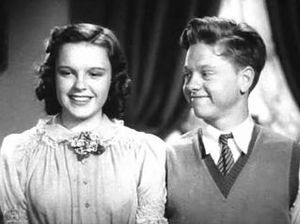
In September 1935, Louis B. Mayer, who ran MGM, asked a songwriter to watch the Garland Sisters perform. A few days later, Judy and her father auditioned at MGM Studios. Judy sang "Zing! Went the Strings of My Heart" and "Eli, Eli." MGM immediately signed Judy to a contract. She was 13 years old. The studio wasn't sure what kind of roles to give her. She was too old to be a child star but too young for adult parts.
Even though she became very successful, Judy faced many challenges in her personal life from a young age. The pressure of being a teenage star affected her health. Film executives often criticized her looks. They thought she wasn't glamorous enough for leading roles. Judy was only about 4 feet 11 inches tall.
Judy felt insecure about her appearance. She went to school at MGM with stars like Ava Gardner, Lana Turner, and Elizabeth Taylor. Even though Judy was a huge success, she sometimes felt like "the ugly duckling." Studio head Louis B. Mayer even called her his "little hunchback."
In her early years at the studio, she was often dressed in simple clothes or frilly, childlike gowns. This was to fit the "girl-next-door" image they created for her. They even had her wear special caps on her teeth and rubber pieces to reshape her nose.
Early Film Roles
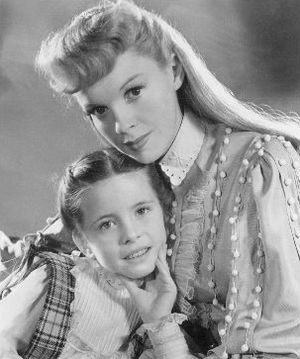
MGM found a winning idea when they paired Judy with Mickey Rooney. They starred in a series of "backyard musicals." Their first movie together was Thoroughbreds Don't Cry in 1937. Then, Judy joined the "Hardy Family" movies. She played a girl-next-door to Mickey Rooney's character, Andy Hardy, in Love Finds Andy Hardy.
They first played lead characters together in Babes in Arms. They went on to make five more films together, including Andy Hardy Meets Debutante and Life Begins for Andy Hardy.
The studio often made Judy go on strict diets, even though her weight was healthy. She was often given only a bowl of soup and lettuce for meals. Despite her success and awards, Judy struggled with self-doubt throughout her life. She always needed to be told she was talented and pretty.
The Wizard of Oz
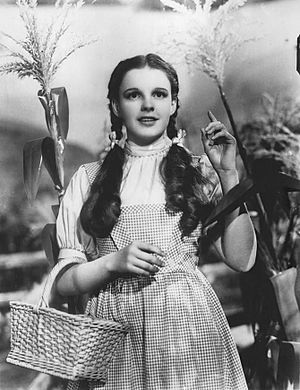
In 1938, Judy was cast in her most famous role: Dorothy Gale in The Wizard of Oz (1939). This movie was based on the 1900 children's book by L. Frank Baum. In the film, she sang the song "Over the Rainbow", which became her signature song. Producers Arthur Freed and Mervyn LeRoy wanted Judy for the role from the start. However, studio chief Mayer first tried to get Shirley Temple and then Deanna Durbin. When they were not available, Judy was finally cast.
At first, Judy wore a blonde wig for the part, but the producers decided against it early in filming. Her blue gingham dress was chosen to make her look younger. Filming began on October 13, 1938, and finished on March 16, 1939. The movie cost over $2 million to make. After filming, MGM kept Judy busy with promotional tours and shooting another movie, Babes in Arms.
She and Mickey Rooney went on a cross-country tour to promote The Wizard of Oz. This ended with a premiere in New York City on August 17. Judy and Mickey had to appear five times a day at the Capitol Theater. During filming, Judy was on a very strict diet.
The Wizard of Oz was a huge success with critics. However, because of its high budget and promotion costs, it didn't make a profit until it was re-released in the 1940s. At the 1939 Academy Awards, Judy received a special Juvenile Award. This was for her outstanding performances in 1939, including The Wizard of Oz and Babes in Arms.
Her Final Years
On June 22, 1969, Judy Garland passed away at her home in Belgravia, London. She was 47 years old.
Her body was taken to New York City on June 26. About 20,000 people waited in line to pay their respects at the funeral chapel in Manhattan. The chapel stayed open all night because so many people came. On June 27, actor James Mason gave a speech at her funeral. He said, "Judy's great gift was that she could wring tears out of hearts of rock." He also said, "She gave so richly and so generously, that there was no currency in which to repay her."
Judy was laid to rest in a crypt at Ferncliff Cemetery in Hartsdale, New York. This town is about 24 miles north of midtown Manhattan.
Judy Garland's son, Joe Luft, now manages her remaining business assets. This includes the rights to her albums, TV specials, and her TV series, The Judy Garland Show. His company, 'Royal Rainbow Productions LLC', handles everything related to her estate.
In 1978, some of Judy's personal items were sold at an auction. Her ex-husband Sid Luft, with the help of her children Lorna and Joe, organized this. Nearly 500 items were sold, from kitchenware to music arrangements. The auction raised $250,000 for her children.
At the request of her children, Judy's remains were moved from Ferncliff Cemetery in January 2017. She was re-interred at the Hollywood Forever Cemetery in Los Angeles, about 2800 miles away.
Legacy
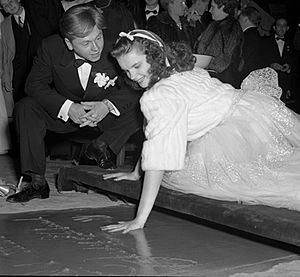
By the time she passed away in 1969, Judy Garland had appeared in over 35 films. She is remembered as one of the greatest entertainers of all time. Many people believe she was the most important American entertainer of the 20th century. She had one of the biggest and most versatile voices in movies. The songs she introduced often won awards. Her film career helped define the Golden Age of Hollywood musicals.
Turner Classic Movies called Judy Garland "history's most poignant voice." Entertainment Weekly compared her to "the Madonna of her generation." The American Film Institute ranked her eighth among the Greatest female stars of classic Hollywood cinema. In 1998, The New York Times wrote that "Garland was a personality on the grand scale who makes our current crop of pop stars look lightweight."
Even today, Judy Garland continues to have fans of all ages. In 2012, she was described as "more than an icon." Like Charlie Chaplin and Lucille Ball, she created a style that others have tried to copy.
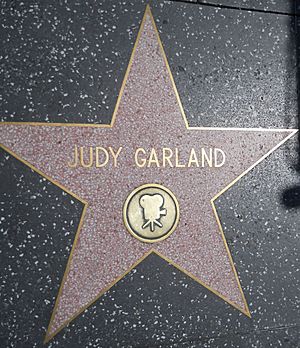
Judy Garland's live concerts near the end of her career are still remembered as "peak moments in 20th-century music." More than two dozen books have been written about her since her death. One popular book is Me and My Shadows: A Family Memoir by her daughter, Lorna Luft. This book was made into a TV miniseries, Life with Judy Garland: Me and My Shadows. The actresses who played Judy in the series won Emmy Awards.
Judy Garland received the Grammy Lifetime Achievement Award in 1997, after her death. Several of her recordings are in the Grammy Hall of Fame. This includes "Over the Rainbow", which was named the number one movie song of all time by the American Film Institute. She has been honored twice on U.S. postage stamps. Once in 1989 as Dorothy from The Wizard of Oz, and again in 2006 as Vicki Lester from A Star Is Born.
Images for kids
-
Mickey Rooney and Judy Garland in Love Finds Andy Hardy (1938).
-
Judy Garland sings "The Trolley Song" in Meet Me in St. Louis (1944).
-
Judy Garland in her dressing room at the Greek Theater (1957).
-
Dean Martin, Judy Garland and Frank Sinatra on the 1962 television special The Judy Garland Show.
See also
 In Spanish: Judy Garland para niños
In Spanish: Judy Garland para niños


